
The Civil Works Administration (CWA) was a short-lived job creation program established by the New Deal during the Great Depression in the United States to rapidly create mostly manual-labor jobs for millions of unemployed workers. The jobs were merely temporary, for the duration of the hard winter of 1933–34. President Franklin D. Roosevelt unveiled the CWA on November 8, 1933, and put Harry L. Hopkins in charge of the short-term agency.
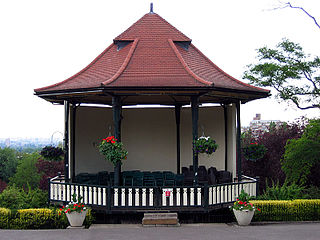
A bandstand is a circular, semicircular or polygonal structure set in a park, garden, pier, or indoor space, designed to accommodate musical bands performing concerts. A simple construction, it both creates an ornamental focal point and also serves acoustic requirements while providing shelter for the changeable weather, if outdoors. In form bandstands resemble ornamental European garden gazebos modeled on outdoor open–sided pavilions found in Asian countries from early times.

Bewabic State Park is a public recreation area covering 315 acres (127 ha) on the shore of Fortune Lake, four miles (6.4 km) west of Crystal Falls in Iron County, Michigan. The state park's rich Civilian Conservation Corps history is evidenced by the CCC structures still in use. The park was listed on the National Register of Historic Places for its CCC-related architecture in 2016.
The Sioux City Symphony Orchestra is an American orchestra based in Sioux City, Iowa. Its home is the Orpheum Theater.
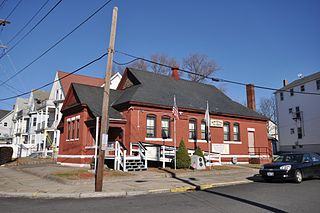
The First Ward Wardroom is a historic meeting hall at 171 Fountain Street in Pawtucket, Rhode Island. It is a single-story red brick building, with a low-pitch gable-over-hipped roof. Basically rectangular, an enclosed entry pavilion projects from the main block. The building, designed by William R. Walker & Son and built in 1886, is one of only three ward halls to survive in the state. Since about 1920 it has been the Major Walter G. Gatchell Post No. 306 of the Veterans of Foreign Wars. The building was listed on the National Register of Historic Places in 1983.
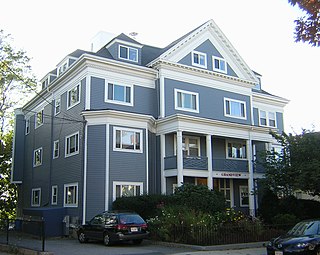
The Grandview is a historic apartment hotel at 82 Munroe Street in Somerville, Massachusetts. This type of building was not uncommon in the city at the time of its 1896 construction. This building affords commanding views of the Boston area from its site near the top of Prospect Hill, and has well-preserved Colonial Revival styling. The building was listed on the National Register of Historic Places in 1989.

Henry Leveke Kamphoefner was a champion of Modernist architecture and is most well known for bringing modern architecture to the southern United States and North Carolina in particular, as the first Dean of the School of Design at North Carolina State University.

The Oleson Park Music Pavilion, also known as the Karl King Bandshell, is located in Fort Dodge, Iowa, United States. The pavilion is associated with Karl King, a famed composer for concert and military bands, who advocated for its construction. It was designed by Henry L. Kamphoefner, a Sioux City architect at that time, who had previously designed the Grandview Park Music Pavilion in Sioux City. It was built as a Works Progress Administration (WPA) project. The WPA paid for 85% of its construction, with the City of Fort Dodge paying the rest. The poured concrete structure was built in a Modernist style with Art Deco overtones. It rises to a height of 36 feet (11 m), and it is known for its acoustical excellence. The pavilion replaced a bandstand that was built in the 1920s in the city square. It was dedicated to King in 1976, and listed on the National Register of Historic Places in 2003.

The Petrillo Music Shell is an outdoor amphitheater in Grant Park in the Loop community area of Chicago in Cook County, Illinois, United States. It serves as host to many large annual music festivals in the city such as Chicago Blues Festival, Chicago Jazz Festival, Taste of Chicago and Lollapalooza.

The W.D. Petersen Memorial Music Pavilion, commonly referred to as the LeClaire Park Bandshell, is located on Beiderbecke Drive in LeClaire Park, Davenport, Iowa. It was listed on the National Register of Historic Places in 1983 and on the Davenport Register of Historic Properties in 1993.

The Sac County Courthouse in Sac City, Iowa, United States, was built in 1889. It was listed on the National Register of Historic Places in 1981 as a part of the County Courthouses in Iowa Thematic Resource. The courthouse is the third building the county has used for court functions and county administration.
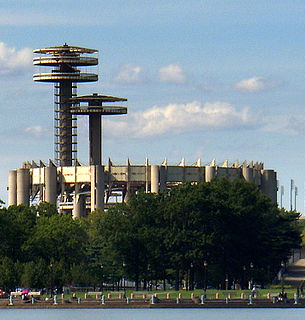
The New York State Pavilion is a historic world's fair pavilion at Flushing Meadows–Corona Park in Flushing, Queens, New York. It was designed in 1962 for the 1964 New York World's Fair by architects Philip Johnson and Richard Foster, with structural engineer Lev Zetlin.

The United States Post Office is an historic building located in Des Moines, Iowa, United States. It was individually listed on the National Register of Historic Places in 1974. It became a contributing property of the Civic Center Historic District when it was established in 1988. It now houses administrative offices for Polk County.
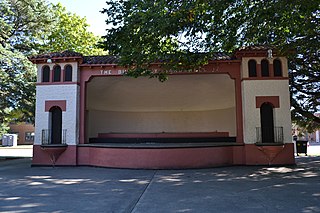
Estes Park Band Shell is a historic building located in Iowa Falls, Iowa, United States. Planning and construction of the band shell were a community project that began in 1931. They engaged Iowa Falls native L.L. Klippel to design the structure, and N.F. Guernsey of Sioux City, Iowa to landscape Estes Park. Completed later in the year, the Mission/Spanish Revival structure features two bell towers with round arch balconies that flank the proscenium arch. There is a cement basement that houses rehearsal space. The walls are stucco, and the structure is capped with a tiled hip roof with bracketed eaves. Over the years the band shell has hosted concerts, dances, and a variety of entertainment activities. Labor unions and political parties have held rallies here. Wendell Willkie spoke here when he ran for president in 1940. The band shell was listed on the National Register of Historic Places in 1993.
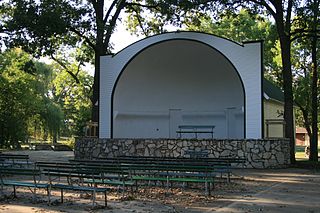
The East Park Band Shell is a historic structure located in Mason City, Iowa, United States. The band shell was individually listed on the National Register of Historic Places in 2009. In 2014 it was included as a contributing property in the East Park Historic District.

The Sioux City Central High School and Central Annex, also known as the Castle on the Hill, are historic buildings located in Sioux City, Iowa, United States. The high school building was listed on the National Register of Historic Places in 1974. The annex was added to the historic designation in 2016.

The Davidson Building is a historic building located in Sioux City, Iowa, United States. It was constructed by local businessmen and real estate developers Ben and Dave Davidson. They saw the need for an upscale office building for professionals. They hired prominent local architect William L. Steele to design the Early Commercial-style structure. It was built by the leading contractor in the city, Lytle Construction Company. Completed in 1913, it was Sioux City's first office building. The exterior of the L-shaped, six-story building is composed of terra cotta panels separated by vertical bands of Roman style brick, and capped with an ornate cornice. It is Sullivanesque in its design. Commercial space is located on the first floor, and office space occupies the upper floors. The building was listed on the National Register of Historic Places in 1999. In 2016 plans were unveiled to convert the building and the adjacent Warrior Hotel into a boutique hotel and apartments. The Davidson Building houses The Warrior Apartments, as well as 56 guest rooms for The Warrior Hotel on its second, third and fourth floors.

Bandshell Park, also known as City Park and Music Pavilion, is located in Ames, Iowa, United States. It is a nationally recognized historic district that was listed on the National Register of Historic Places in 1999. At the time of its nomination it consisted of six resources, which included one contributing building, one contributing site, two contributing structures, one contributing object, and one non-contributing object. The park, located to the east of the central business district, was gift to the city in 1884 from the C&NW Land Company. The full city block was the first park established in Ames.

The Grey Eagle Village Hall is a multipurpose municipal building in Grey Eagle, Minnesota, United States. It was built in 1934 as a federally funded New Deal project to create jobs during the Great Depression. It originally contained local government offices, a fire station, and a community auditorium. The building was listed on the National Register of Historic Places in 1985 for having local significance in the themes of architecture and politics/government. It was nominated for being a superlative example of the public works projects of the Civil Works Administration.
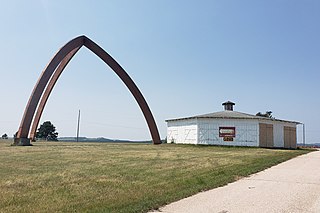
The Sitting Bull Crystal Cavern Dance Pavilion is a historic event venue on the south side of U.S. Highway 16 northeast of Rockerville, South Dakota. Built in 1934, it hosted the Duhamel Sioux Indian Pageant, a Lakota tourist performance created by Black Elk in 1927. The pageant ran every summer until its discontinuation in 1957. A major attraction in the 1930s, its purpose was to not only profit off of tourism to the nearby Black Hills and Mount Rushmore but also—according to Black Elk—to represent Lakota traditions in a respectful, authentic way. It was added to the National Register of Historic Places in 1995 as a venue of enduring cultural and religious significance, and for its association with Black Elk.






















